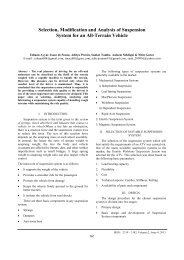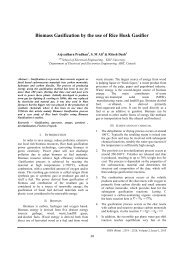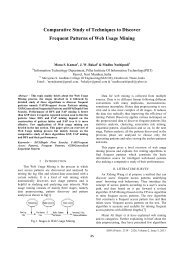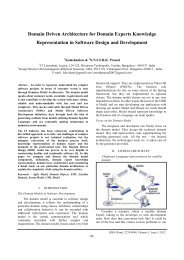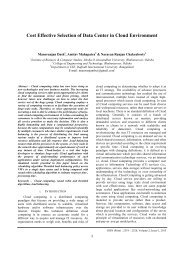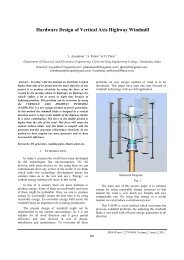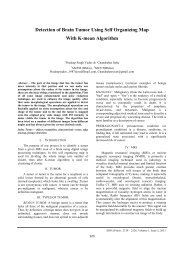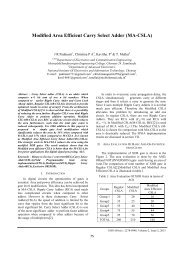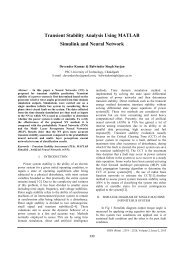Numerical Analysis of Flow through Shrouded Turbine ... - IRD India
Numerical Analysis of Flow through Shrouded Turbine ... - IRD India
Numerical Analysis of Flow through Shrouded Turbine ... - IRD India
Create successful ePaper yourself
Turn your PDF publications into a flip-book with our unique Google optimized e-Paper software.
International Journal on Theoretical and Applied Research in Mechanical Engineering (IJTARME)this mesh is considered to be the best. This meshformation was done with GAMBITIII. RESULTS AND DISCUSSIONA. Pressure Coefficient Of <strong>Turbine</strong> BladesThe pressure coefficient <strong>of</strong> over the blades <strong>of</strong> theturbine rotor stage is shown in the figure-5. The turbinerotor stage consists <strong>of</strong> 43 blades arranged with theangular orientation <strong>of</strong> 8.73 degrees between each blade.From the figure-5 it is observed that, the pressurecoefficient is maximum at the leading edge <strong>of</strong> the bladewhich represents the stagnation point <strong>of</strong> the blade. Thepressure coefficient is minimum at the suction sidewhich represents the velocity is maximum at thatlocation.6. From the figure, it is observed that, the pressurecoefficient is maximum at the leading edge <strong>of</strong> the bladewhich represents the stagnation point <strong>of</strong> the blade. Thepressure coefficient is minimum at the suction side andnear the trailing edge which represents the velocity ismaximum at that location.The contour <strong>of</strong> pressure coefficient on the suctionside <strong>of</strong> the blade is shown in the figure-7. It is observedform the contour that the pressure coefficient isminimum and there is a small variation in the pressurecoefficient near the hub and shroud <strong>of</strong> the blade, due toend wall boundary layer formation and wake formationbecause <strong>of</strong> the highly curved surface <strong>of</strong> the blade. Thecontour <strong>of</strong> pressure coefficient on the pressure side <strong>of</strong>the blade is shown in the figure-8.Fig. 5 pressure coefficient distribution along the span<strong>of</strong> the bladeThe pressure coefficient variation along the span <strong>of</strong>the blade is plotted in figure-5. It is observed thepressure coefficient decreases near the hub and shroud<strong>of</strong> the blade. It is observed that the decrement in thepressure is due end wall boundary layer creation nearthe hub and shroud <strong>of</strong> the blades.Fig. 7 : Pressure Coefficients on Suction Surface <strong>of</strong> theBladeFig. 6: Pressure Coefficient at the Mid-Section <strong>of</strong> the BladeThe pressure coefficient variation over the bladesurface at the midsection <strong>of</strong> the blade is shown in figure-Fig. 8 : Pressure Coefficient On The Pressure SurfaceOf The BladeIt is observed form the contour that the pressurecoefficient is higher than that <strong>of</strong> suction side and there isa small variation in the pressure coefficient near the huband shroud <strong>of</strong> the blade, because <strong>of</strong> end wall boundarylayer formation and wake formation because <strong>of</strong> thehighly curved surface <strong>of</strong> the blade.3ISSN : 2319 – 3182, Volume-2, Issue-3, 2013
International Journal on Theoretical and Applied Research in Mechanical Engineering (IJTARME)B. Cascade <strong>Analysis</strong> Of <strong>Turbine</strong> Blade PressureCoefficients On Surface Of BladeThe pressure coefficient variation over the cascadedblade surface at the midsection <strong>of</strong> the blade is shown infigure-9. From the figure, it is observed that the pressurecoefficient is maximum at the leading edge <strong>of</strong> the bladewhich represents the stagnation point <strong>of</strong> the blade. Thepressure coefficient is minimum at the suction side andnear the trailing edge which represents the velocity ismaximum at that location.Fig. 9 : Pressure Coefficient On The Cascaded Blade SurfaceThe contour <strong>of</strong> pressure coefficient on the pressureside <strong>of</strong> the blade is shown in the figure-10. It is observedform the contour the pressure coefficient is minimum atthe center <strong>of</strong> the blade because <strong>of</strong> wake formation on theblade and there is a small variation in the pressurecoefficient near the hub and shroud <strong>of</strong> the blade,because <strong>of</strong> end wall boundary layer formation on thesurface <strong>of</strong> the blade. The contour <strong>of</strong> pressure coefficienton the suction side <strong>of</strong> the blade is shown in the figure-10. It is observed form the contour the pressurecoefficient is lower than that <strong>of</strong> pressure side and thereis a small variation in the pressure coefficient near thehub and shroud <strong>of</strong> the blade, because <strong>of</strong> end wallboundary layer formation and wake formation because<strong>of</strong> the highly curved surface <strong>of</strong> the blade.Fig. 10(b) : Cp distribution on pressure surfaceC. End Wall Boundary Layer Separation On CascadedBladesEnd-wall loss is also known as secondary loss, andis related to the passage and the horseshoe vortices. Dueto these loses, the pressure coefficient near the hub andshroud <strong>of</strong> the blade decreases as shown in the figure-11.Fig. 10(b) : Cp distribution on suction surfaceFig. 11 : End Wall Boundary Layer SeparationD. Leakage <strong>Analysis</strong> Through Shroud Z-Gap PressureCoefficients On Surface Of BladeThe pressure coefficient variation over the surface<strong>of</strong> shrouded turbine blade with 2mm z-gap at the midsection<strong>of</strong> the blade is shown in figure-12. From thefigure, it is observed that, the pressure coefficientdecreases on the suction side <strong>of</strong> first blade because <strong>of</strong>the gap between shrouds.4ISSN : 2319 – 3182, Volume-2, Issue-3, 2013
International Journal on Theoretical and Applied Research in Mechanical Engineering (IJTARME)Fig. 12 : Pressure Coefficient <strong>of</strong> shrouded blade with2mm z-gap (mid-section)Due to the gap near the shroud, the end wallboundary layer separation decreases as shown in thepressure coefficient contour in figure-13. The first figshows the Cp contour on pressure surface and second figshows the Cp contour on suction surface.Fig. 13 Cp distribution on blade surfaceE. Comparison Of <strong>Shrouded</strong> Blades With Gap AndWithout GapFrom the above fig 14 it is observed the pressurecoefficient on pressure side <strong>of</strong> blade 1 lowers because <strong>of</strong>the large end wall boundary layer formation on thecascaded blades without gap but on the shrouded bladewith 2mm gap the pressure coefficient is same as that <strong>of</strong>the reference pressure. It is also observed the pressurecoefficient on suction side <strong>of</strong> blade 1 increases due tothe large end wall boundary layer formation on thecascaded blades without gap but on the shrouded bladewith 2mm gap the pressure coefficient is same as that <strong>of</strong>the reference pressure. Thus due to 2mm z-shroud gapon the turbine blades shrouds the end wall boundarylayer is reduced by the leakage <strong>of</strong> primary airflow<strong>through</strong> the 2mm gap between the shrouds.Fig. 14: Cp Of Blade With Gap And Without GapIV. CONCLUSIONThe effect <strong>of</strong> the turbine rotor blade shroud z-gapon the pressure coefficient distribution on the surface <strong>of</strong>the blades is analysed. It is found there is decrease in thepressure coefficient near the shroud <strong>of</strong> the turbine blade.Although there is a decrease in the pressure coefficienton the surface <strong>of</strong> the blade but it reduces effect <strong>of</strong> endwall boundary layer separation near the shroud <strong>of</strong> theturbine blade because <strong>of</strong> the leakage <strong>of</strong> primary flow<strong>through</strong> the gap between the shrouds.V. FUTURE WORKThe present computational work has to carried outon the models with different shroud gaps such as 0.25mm, 0.5mm, 0.75mm, 1mm, 1.25mm, 1.5mm and1.75mm to find out the optimum gap size for betterperformance <strong>of</strong> the blade in the engine. Experimentalwork has to be done by creating the model and analyzethe model with the same conditions as that <strong>of</strong>computational analysis. The experimental results can beanalyzed with the computational results for verification<strong>of</strong> results. If both the results are same it can beimplemented in turbine engines for various applicationsVI. REFERENCES[1] Villiers, J. D., & Govender, S. (2003). validation<strong>of</strong> a CFD Static Pressure Distribution againstExperimental Data for a <strong>Turbine</strong>. R & D Journal,19(3), 3–5.[2] Ameri, A. A., Park, B., & Steinthorsson, E.(1996). <strong>Analysis</strong> <strong>of</strong> Gas <strong>Turbine</strong> Rotor andShroud Heat Transfer Blade Tip (p. 10).[3] Maier et al, inventor; 1991 Jan.11. Gas turbineblade shroud support. United States patent US5,022,816.5ISSN : 2319 – 3182, Volume-2, Issue-3, 2013



